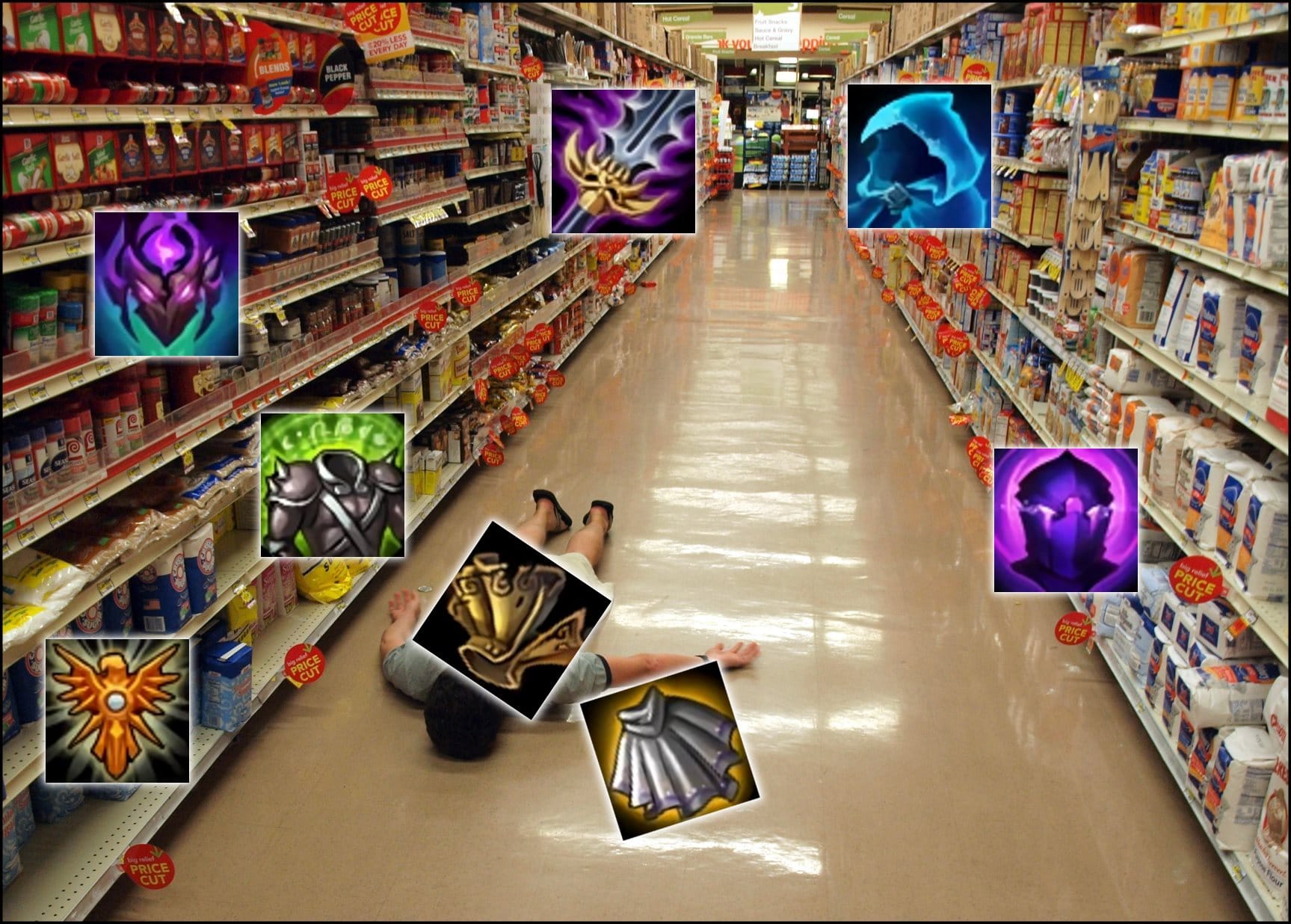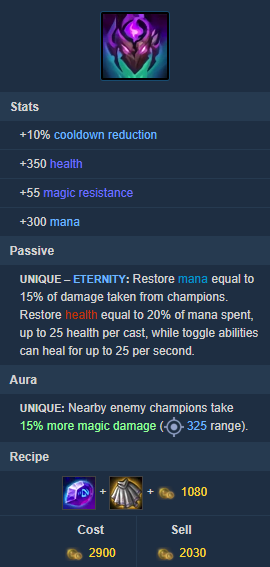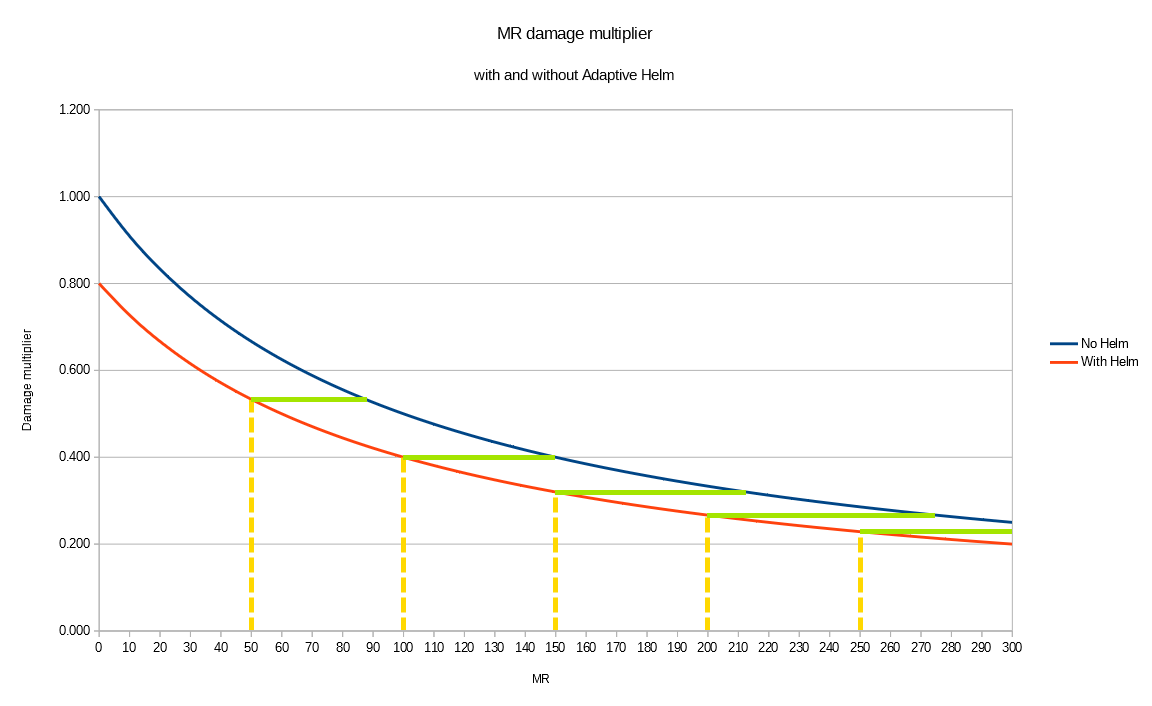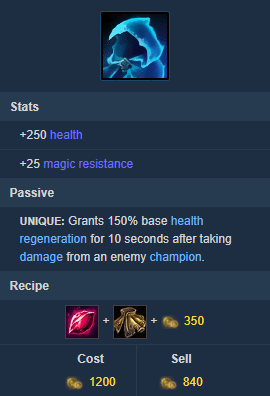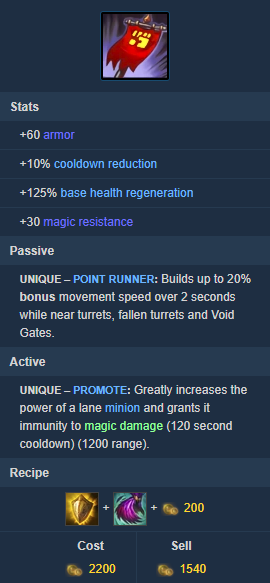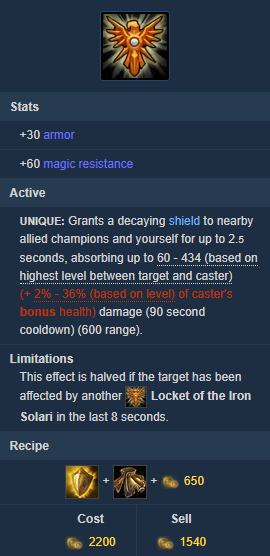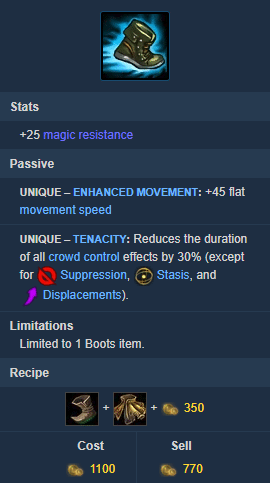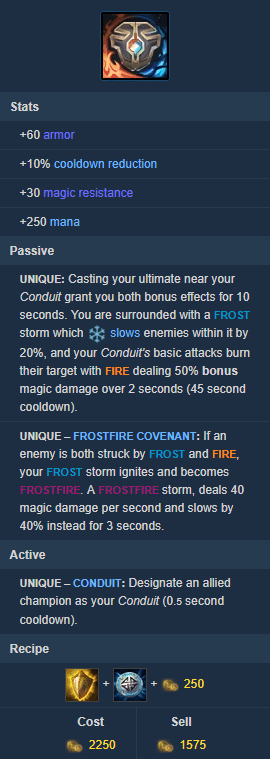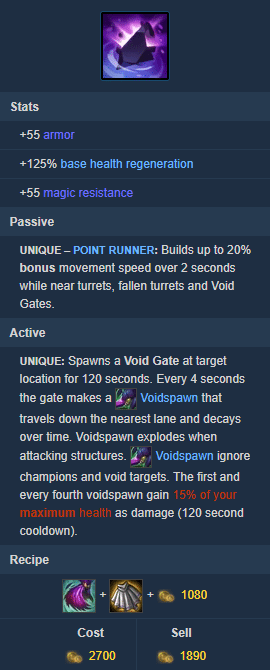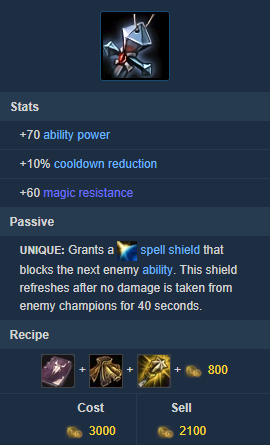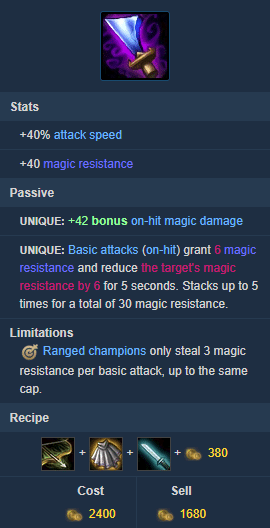For armor itemisation, check out the previously written companion post covering just that.
Many a time a player has asked “What should I buy?”
Perhaps more specifically, you might ask “This Singed is dumping on me in lane; what should I buy?”, or “Corki is wiping the floor with me every fight; what should I buy?”
If you play tanks / fighters (bruisers), then fret no more! Consider this a guide made just for you. It covers any magic resist item you would or should reasonably consider purchasing in the game. If you don’t play either of these two classes, the article may still be of assistance, just somewhat less applicable.
Important Prerequisite
It’s really important and/or helpful to understand that Everything is Roughly Balanced. In this context, that means that an item that does something is worth buying if you can make good use of the thing it does. Yes, some items are a little strong or a little weak overall, but all of them still fill their own niche.
Big Ticket Defensive MR Items
Per the explanation in the Armor version of this article, “big ticket” in the context of items means the completed major items in a category.
For example, Phantom Dancer would qualify as a “big ticket” AS / Crit item, but Zeal would not. Similarly, Void Staff is a “big ticket” AP item, but Blasting Wand isn’t.
Since there are some offensive MR items, I’ve specifically kept this category to the defensive-focused ones so that comparisons will be both more useful and easier to make. For the same reason, I’ve also segmented team-utility MR items into their own section.
Abyssal Mask
The three main MR+HP items are pretty similar in their base stats, so each relies on some kind of unique effect in order to differentiate within the lineup.
Many people see Abyssal Mask and think that its unique aspect is its aura, but for tanks and fighters the more practical property is actually its mana and in-combat sustain. It’s perfectly normal for a frontliner to use hundreds of mana during a team fight as they cycle through all of their abilities, which in turn means that Abyssal Mask realistically provides a total health pool closer to 450 than 350.
The damage boost is a nice bonus, although as of writing this article it looks like the range is going to become quite low in an upcoming patch, limiting its utility unless you’re right on top of the guy you’re fighting. Still, for magic-damage fighters/tanks it can provide a modest boost to the total damage output of not only you but your team.
Adaptive Helm
Although it has slightly less straight up stats than either of the two direct alternatives, Adaptive Helm also has the ability to provide the largest defensive increase against most sources of magic damage.
The passive 20% reduction can apply independently to each source of successive damage simultaneously. For example, if Corki autoattacks you once, that damage will be tracked independently from his ult’s rockets. Against champions that do damage frequently using the same source (Corki is again a great example), this item can be exceptionally good value.
In this graph, the blue plotted line shows how much effect your MR has on incoming magic damage, while the red line shows the equivalent with Adaptive Helm’s passive. For example, at 100 MR with no Adaptive Helm, incoming magic damage suffers a 0.5x multiplier: a 50% reduction.
The green line shows how much MR you would need to buy in order to gain 20% additional damage reduction at each of the dotted yellow lines (increments of 50 MR).
If you have 45 MR, buying this item would put you at 100 total MR (the second set of lines). The passive effect would then be equivalent to having another 50 MR for any affected incoming damage on top of the 55 MR the item already provides (!). At 200 MR the effect is equivalent to over 70 MR. Even better is that although MR will be partially mitigated with Void Staff and other percentage penetration, Adaptive Helm’s passive won’t – it isn’t directly affected by magic penetration.
When facing champions that repeatedly damage you with the same magic damage ability, Adaptive Helm offers amazing value.
Spirit Visage
For quite a while in Season 6 and early Season 7, this was the standard defensive MR item for basically all tanks and fighters. Granted, that was mostly because Adaptive Helm didn’t actually exist at the time, but Spirit Visage has still retained an element of that “generic purchase” identity in its current iteration.
Spirit Visage has slightly higher base stats than Abyssal or Adaptive (+100 HP and higher guaranteed regen), and its unique effect is somewhat less situational. Even if you have absolutely no other sources of healing, Spirit Visage will still apply to your champion’s base regen and the 100% health regen the item itself supplies, meaning that the item effectively comes with a total of 160% health regen out-of-the-box.
Of course, other healing effects sweeten the deal. If you have a Soraka or Sona on your team, then Spirit Visage gains a bit of synergy. Ocean Drake, potions, life steal, healing from your kit (e.g. Maokai, Aatrox) – there’s lots of things that Spirit Visage’s passive will apply to. Technically there’s also some good synergy with the passive of Warmog’s, but I’d argue that the healing effect of that is so strong already that boosting it any further usually has no practical benefit. If you can heal to full while out of combat in under 20 seconds, cutting that down to ~15 isn’t that big of a deal.
If you want a big defensive MR item, but don’t have any benefit from the unique aspects of Abyssal Mask (mana + magic damage amplifying aura) or Adaptive Helm (defensive boost vs same-source magic damage), Spirit Visage might be the best option due to process of elimination. Obviously if you have synergy-effects then it can become a competitive option even if the other two items are in play. Spirit Visage’s flexibility comes at the cost of power: if you can make good use of the effect of Abyssal or Adaptive, then even with kit-synergy it’s hard for Spirit Visage to match their effectiveness.
Honorable Mention: Gargoyle Stoneplate
Although I don’t technically consider Gargoyle Stoneplate equivalent to the other three items in this category, it does just barely squeeze in de facto.
There are two main influencing factors why I think it’s worth mentioning this here.
Firstly, although the item provides less MR than the three items above by default, it still provides something close (40 vs 55), and has the potential to provide more if you activate its passive. Champions generally build less total MR than armor, so it’s easier to “fit in” a half-half item on the MR side of things than the armor side of things (that is to say, if you “need an MR item”, you can often get away with just what Stoneplate provides).
Secondly, most duelist threats rely on physical damage, generally because they require autoattacks to deal some or most of their damage. That means that usually when you’re actually facing major magic damage (team fights), you’ll activate the passive fairly reliably anyway, bumping the item’s MR to a near-stable 80 when you need it most. There are exceptions of course (Vlad, AP Kennen), but for the most part you need MR more often when team fighting than when split pushing.
Although the active is a boon for tanks, it’s also worth noting that you don’t have to use it. You do absolutely have the option of just treating the item as an 80 armor / 80 MR team-fighting item with an “oh crap” option if you get caught out of position – it’s solidly gold efficient with just the stats and passive in play. Most fighters will generally want to go through the majority of a fight without popping the active so as to not reduce their damage output, while tanks probably want to pop it after they’ve expended their initial cooldown rotation.
Big ticket MR item summary
| Item | Cost | HP | MR | Niche |
|---|---|---|---|---|
| Abyssal Mask | 2900 | 350+ | 55 | Has mana, good for very long fights, aura boosts magic damage |
| Adaptive Helm | 2800 | 350 | 55 | Randuin's-esque damage reduction vs "successive" same-source magic damage (e.g. Karthus, Corki, Singed) |
| Spirit Visage | 2800 | 450 | 55 | Healing amplification, slightly more "generic" (making worst case scenario less-bad) |
| (Gargoyle Stoneplate) | 2500 | 0 (+100%*) | 40 (+40**) | Mixed resists for team fighting |
* When using the active effect.
** While the passive is activated.
Budget
Sometimes you’re strapped for cash and just need something before the next fight breaks out. Maybe you just don’t need that much MR and want to spend your gold on other stats. For either of these cases, here are the limited low cost MR options.
Null-Magic Mantle / Negatron Cloak
Let’s be realistic with these purchases – if you are drowning in magic damage late into the game, neither of these will be enough to keep you afloat. However, they are the purest form of MR available, and therefore by definition the most cost efficient way to get just MR.
Null-Magic Mantle and Negatron Cloak both offer the same gold efficiency (18 gold per point of MR), but differ in their use case. Null-Magic Mantle is only a “light” MR purchase at 25 MR, but gives you the flexibility of building into any MR item in the game. Most MR items can’t build out of a Negatron Cloak, so if you want to stop-gap on some MR while you’re getting more gold, Null-Magic Mantle might be your only option.
Negatron Cloak offers notably better slot efficiency (40 MR is >50% more than 25 MR), but your upgrade options are quite limited in number. Fortunately, most tanks and fighters would have no issue with Gargoyle Stoneplate in their build, and Abyssal Mask and Zz’Rot Portal are also fairly attractive as well. If you just need a modest MR boost in your build (but need other things like armor more), then Negatron Cloak can be a great purchase. If bought as your only source of additional MR, it’ll give you enough MR to significantly reduce incoming magic damage and you can then pump your gold elsewhere.
Spectre’s Cowl
Despite being a budget MR-item option, Spectre’s Cowl doesn’t actually give you any more MR compared to Null-Magic Mantle. That’s really important, because it means that if you’re on a tight budget and need to spend as little as possible on MR, you should probably not buy this.
That’s not to say this item should never be purchased – it just has a more specific use case than the pure MR of Null-Magic Mantle and Negatron Cloak.
The regen is very effective against light poke and harass, greatly reducing the sticking power of damage that you take. That makes it more of a laning item than anything else though – great if you want a defensive pickup vs Vlad in lane, but kind of crap if you’re trying to build up to an Adaptive Helm or Spirit Visage later in the game when fights only last 10 seconds anyway. If you want/need one of those items then you have little choice, but if you can make good use of Abyssal Mask or Gargoyle Stoneplate then you can get the 40 MR of a Negatron Cloak instead of getting stuck at 25 MR.
Utility
As you’d expect, these items are more focused on utility instead of stats compared to the big ticket MR items. That means that they’re generally not the most efficient purely-defensive option, but you can also find unique effects on these items that are unavailable elsewhere.
Banner of Command
Infamously effective on Patch 8.4, a much needed subsequent nerf saw this item fall back out of favor in most games.
Despite that, it’s still an effective purchase depending on the needs of you and your team. Check out the notes from my previous article on Armor itemisation for my thoughts – but remember that Banner only provides 30 MR, so should not be considered if you need to maximise your durability against magic damage specifically.
Locket of the Iron Solari
If you consider Locket’s active shield to be an HP boost (which it’s reasonable to do), then this is actually competitive as a purely selfish MR item. It provides 5 more MR than the big ticket items while having a similar amount of “HP” if you consider that although the shield strength scales with level, you probably won’t have this bought until at least level 10.
From there it only gets better, since the shield will continue to scale and you can apply it to your team mates in fights as well. Locket is seen in nearly every game of League of Legends and there’s a very good reason why – it’s so generically effective with almost no downside.
The only reason why you don’t see three of these every game is the lockout effect – if someone has recently received Locket’s shield, subsequent Locket shields in the following 8 seconds only provide half the shield amount. Because of that, it makes sense to push Locket onto a supportive champion (tank supports, tank junglers) and leave the better-scaling tanks the option of more selfish itemisation.
If you’re a supportive tank, then you should definitely be considering a Locket in your build if the enemy team has any meaningful magic damage. For fighters, I’d only recommend it if your team would really benefit from it, or if your own ability to use the gold is quite poor compared to your allies (e.g. if you’re behind but your carries are ahead, that would be a reason to consider an item like this).
Mercury’s Treads
Tenacity gives you more combat uptime if facing repeated CC and reduces the likelihood that getting caught results in death. Looking at the movement speed of this item is a bit of a misnomer, as in that respect you should be comparing it to other boots options (which give movement speed anyway).
Critically important to note is that this is an extremely gold-inefficient choice as an MR-only purchase. The upgrade from Null Magic Mantle nets you a grand total of 0 additional magic resist. You should never buy these “because you need MR” – buy them if you need tenacity, or if you could benefit from having both tenacity and MR on your boots purchase.
Zeke’s Convergence
Like Banner, I wouldn’t consider this item if you’re looking to maximise durability against magic damage. 30 MR for a completed item is simply inadequate against significant incoming magic damage, but if your MR needs are modest it may suffice. Check out the notes in my previous article on armor itemisation for my thoughts.
In short though: it’s a pretty good pickup as a sort of “Ardent Censer for tank supports”. In most other situations I’d look elsewhere for your item purchase.
Zz’Rot Portal
This item fills a similar niche to Banner, with a vaguely similar stat profile as well. I’ve discussed my thoughts on the item in my previous article on armor itemisation.
Damage
Unlike with armor items, there are actually a handful of MR items that also dual-duty as damage items. Let’s take a look.
Abyssal Mask
Although this does technically qualify as a damage-increasing item, it’s power distribution is more focused on its defensive properties than its offensive ones – I would not consider it anywhere close to an even split of damage vs durability. As such, check out the notes for this under the “Big Ticket MR Items” section.
Banshee’s Veil
This is something I would rarely if ever recommend on tanks and fighters. A reasonable amount of the item’s power budget is spent on the shield, and the item compares poorly to its peers if you take that away. On squishy champions that generally stay further back, that shield can be extremely valuable, but on frontliners like yourself who are the ones eating most of the poke, it’s too easy for the enemy team to pop the shield with a low value ability like an Ezreal Q. Further, you’d rarely be the target a high priority initiation ability (like Amumu Q or Blitz hook) – and even if you are, you’d often be just as happy with the ~400 HP of one of the other MR items as you would with once-off blocking the damage of one ability.
Beyond that, the item is also half AP by gold value, which immediately eliminates all AD champions from considering it. The remaining tanks and fighters that do have meaningful AP scaling would still generally prefer to not spend so much gold on AP. It’s simply inefficient itemisation on most fighters and tanks to index too heavily on damage and not enough on durability – if you die you can’t do your job in a fight.
The moderately high cooldown of Banshee’s makes it a poor item for laning phase, in turn making it a poor first item and perhaps even a poor second item in a build. Once you get to a third item, the damage boost of Banshee’s would already be beginning to slowly become insignificant compared to the damage output of full-fledged carries, making you wish you’d have just bought something else instead. Being behind-curve on your defensive itemisation as a front-liner is no fun at all.
If you’re wanting something kind of like Banshee’s you could instead consider Abyssal Mask – it still provides some extra damage, but has much higher total durability.
Hexdrinker / Maw of Malmortius
If you’re thinking about purchasing either of these items, no doubt you’re facing meaningful amounts of magic damage. In that case, the magic-damage-only shields can essentially just be considered health when calculating your total durability.
Even conservatively, it’s realistically impossible to buy Hexdrinker until at least level 5, at which point the shield is “150 HP” – the same as a 400g Ruby Crystal. With additional levels the shield continues to scale up to a maximum of 280, making the value proposition marginally better over time from a pure stats perspective.
Even without its shield, Hexdrinker is actually already gold efficient, so having that shield turns it into an incredibly efficient item – virtually unparalleled in its price bracket for value. As for the distribution between damage and durability, your gold is spent more towards the durability side of things – roughly 2:1 in favor of durability when counting the value of the shield.
Maw maintains a similar item niche as Hexdrinker, but it’s not just “double-Hexdrinker”. For a total cost well over twice that of its younger sibling, Maw actually provides less than double of the same stats – instead of “just more stats”, it goes for some additional unique effects, namely 10% CDR and an additional boost of +20 AD, +10% spell vamp, and +10% life steal when the shield is activated. The ratio of damage to durability on Maw also changes significantly compared to Hexdrinker, and is much more like 3:2 in favor of damage – close to the opposite of what Hexdrinker provides.
Via MR scaling, the shield strength of Maw is generally going to be 350~450 unless you’re buying an absurd amount of MR. That statline begins to draw comparisons with some of the major defensive MR items, which also feature similar amounts of HP and MR, while likewise providing the same 10% CDR. If you can reliably make use of Maw’s effects in combat, then it represents an excellent value purchase, providing a large stat-boost compared to those items for only a small price increase.
As offensive MR items, obviously both Hexdrinker and Maw are only suitable on champions that will actually use extra AD – AP champions should look elsewhere. For champions like Olaf and Jarvan, these two items are also often the only viable choice for that item niche. That’s not to say that they’re bad item choices, there’s just not much competition in the “offensive MR” item space unless you’re squishy (QSS/Mercurial) or want attack speed (Wit’s End).
Hexdrinker and Maw are both good at what they do, so the lack of choice is not inherently a problem. If AD + MR + pseudo-HP sounds good to you, then either item should suit you splendidly.
Mercurial Scimitar (QSS)
Very few tanks and fighters should consider this instead of Maw. It’s more expensive, provides significantly less durability (lower MR + no shield at all), and the QSS active — the item’s primary selling point — is aimed squarely at squishies hiding in the back, not burly dudes standing in the front.
On average, front-liners with a QSS effect will be less useful than front-liners with 20% more durability and extra gold in their pocket. Squishies often worry about getting hit by a single CC ability, but tanks mostly worry about CC like that if it’s chained – in which case tenacity would be the route to go, not the single-CC-negation of QSS.
Speaking of QSS itself, so much of the power budget of the item is spent on the active that it should basically never be considered if you’re specifically looking for MR. Buy it for the active and consider the MR a bonus. Much of that recommendation carries over to Mercurial Scimitar – it just doesn’t compare favorably to other items unless you really value the QSS effect.
You can consider getting this on something like Fiora or Gangplank – great AD scaling, somewhat squishy, and heavily focused on split-pushing (where there’s less total CC coming your way). Anyone who doesn’t tick all three boxes is almost always better off with a Maw – or simply another MR item altogether.
Wit’s End
Another somewhat niche item. Most tanks and fighters that are willing to spec into damage scale with AD but not Attack Speed, making Maw a better option.
What Wit’s End does have going for it is a much lower cost, and superb gold efficiency for those who can use it effectively. I’d love to see this picked up a little more on champions like Jax and Shen – their existing magic damage and AS-scaling make them prime candidates for it.
One issue with needing to stack the item is risk/unreliability: to make full use of the item you have to commit to a deep trade or all-in. It’s not as efficient if you’re just doing short trades here and there, and close to worthless in a poke situation.
Another concern is middling slot efficiency, but I personally don’t think that’s too much of an issue for this class of champions. It’s quite rare for them to reach full build, so gold efficiency is a more important metric than slot efficiency for them in my opinion.
If you autoattack a lot and are willing to buy what is a mostly-damage item, this is actually a good pickup – just be wary of being too greedy in your item build. If you need durability more than damage, buying this could be detrimental to your effectiveness in fights.
Recap / tl;dr
- Abyssal Mask: Major defensive MR item; niche: mana / damage aura.
- Adaptive Helm: Major defensive MR item; niche: exceptional vs magic damage from repeated application of same abilities (e.g. vs Singed, Corki).
- Spirit Visage: Major defensive MR item; niche: healing amplification, more generic stats than alternatives.
- Gargoyle Stoneplate: Efficient mixed-defense for team fights.
- Null-Magic Mantle: Pure MR (maximum gold efficiency for just MR). Very flexible – can build into any other MR item.
- Negatron Cloak: Pure MR (maximum gold efficiency for just MR). Much improved slot efficiency vs Null-Magic, but less upgrade options.
- Spectre’s Cowl: Good vs light-moderate poke / harass. Not as good vs all-in damage due to slow regen effect.
- Banner of Command: Low MR. Good for split-pushing or aiding own push (especially with Baron buff)
- Locket of the Iron Solari: Team-utility version of major defensive MR item. Efficient when just shielding self, unrivaled when shielding whole team. Not as good when stacked, so usually best bought on supportive champions.
- Mercury’s Treads: Awful gold efficiency for just MR. Buy for its tenacity, which can increase your uptime in fights if you get chain CC’d.
- Zeke’s Convergence: Low MR. Can be good for boosting a carry’s damage, but is definitely a more supportive item (i.e. mostly for tank supports).
- Zz’Rot Portal: Mixed defensive item. Self-contained ongoing push pressure (compare to once-off of Banner). Best used for split-pushing.
- Banshee’s Veil: Not recommended for most tanks/fighters – too much spent on AP and the shield is not effective on this class of champions.
- Hexdrinker: Great pickup if you want AD + MR + “HP”. Has more defensive than offensive power.
- Maw of Malmortius: Great pickup if you want AD + MR + “HP”. Has more offensive than defensive power. Actually compares quite favorably to major defensive MR items if you can efficiently use the AD and unique aspects.
- QSS: Terrible for just MR – buy for the effect and consider the MR a bonus. Also not worthwhile on most tanks / fighters. If CC is an issue, consider tenacity instead.
- Mercurial Scimitar: Almost always worse than Maw for tanks / fighters. Expensive, but very low durability increase compared to cost. If CC is an issue, consider tenacity instead. Can be considered on squishy AD-scaling split-pushers such as Fiora.
- Wit’s End: Efficient if you autoattack a lot, but doesn’t provide as much durability as most other MR items. Good damage increase for those who can use it. Slot efficiency isn’t the best, but generally a non-issue.
